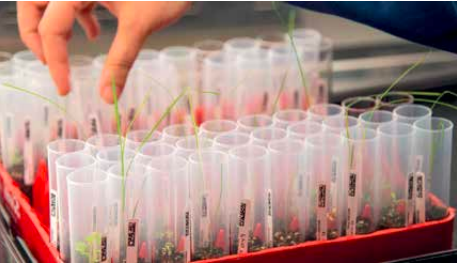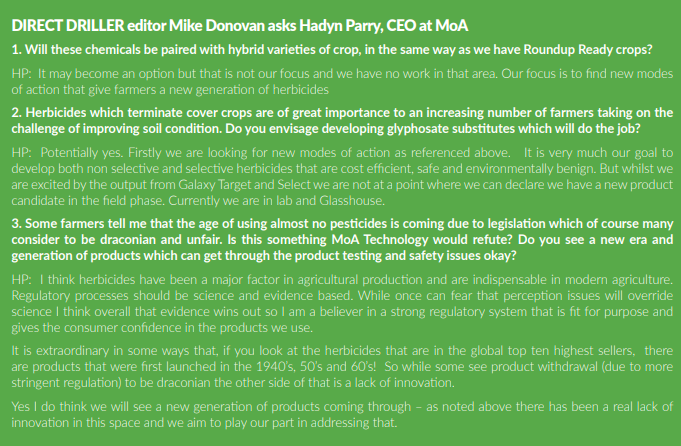Weed resistance is becoming a major issue for crop production. The International Survey of Herbicide Resistant Weeds
collates information from researchers worldwide on the spread of weed resistance. Today resistance is present in more
than 250 weed species infesting nearly 100 crops and affecting 23 of the 26 known herbicide modes of action. Looking
at the highest selling herbicides globally many have resistance issues. Glyphosate is the most prominent as it is such an
important product and used so widely, and often, but resistance issues affect most herbicides to some degree – which is
why discovery of new modes of action is so critical
Written by Direct Driller editor, Mike Donovan.
Frequent application of a herbicide or herbicides with the same mode of action exerts selection pressure on weed populations. If surviving weeds are fit enough to reproduce and establish a population then resistance arises. The root of the problem is the difficulty in finding new herbicide modes of action.
Herbicides accounted for more than 40% of the global market for crop and non-crop pesticides worth $64 billion in 2018 Selective herbicides, such as 2,4-D and MCPA invented in the 1940s started the move away from various forms of hand and mechanical weeding, yet still continue in many developing countries. It is increasingly difficult to find enough labour at the right time and at affordable wages to manually control weeds. Problems are exacerbated by the movement of people away from the countryside to work in cities. Often it falls to women and children to do the backbreaking work of hoeing, slashing or pulling weeds.

Having cleared a field, the job has to be repeated in just a short space of time as new flushes of weeds emerge. In many developing countries, herbicides free women, in particular, to feed, educate and care for their children. Hand weeding one hectare of maize can take 250 person-hours of work, while it can take just two hours for one person to apply herbicide from a knapsack sprayer to the same crop area. With weed control taking a fraction of the time needed previously, herbicides allow smallholders to supplement their income from additional employment.
From the 1960s, non-selective herbicides (paraquat from the 1960s and glyphosate from the 1970s), enabled the adoption of no-till (direct drilling; zero tillage) and other reduced cultivation systems for crop production to be established. If weeds are removed by herbicides before planting, then there is no need to plough to bury weeds. No-till systems can increase yields when crops are appropriately established and have many environmental and economic benefits.
The benefits of no-till systems, include
1. reduced labour;
2. reduction in soil erosion;
3. water conservation;
4. reduced fuel and energy used;
5. reduced greenhouse gas emissions;
6. greater biodiversity.
Combating climate change is especially topical. Ploughing aerates the soil excessively, causing the oxidation of organic matter. Not only does this destroy good soil structure (built-up after rotational pasture, for example), but it releases large amounts of carbon dioxide. Spraying a herbicide to burn down weeds before planting in a no-till system can reduce emissions of CO2 by more than 80%.
Fundamental research at Oxford University
Research scientists have developed new methods of developing the next generation of herbicides. The research is a new spin-off from the university in the shape of MoA Technology, launched to confront the global herbicide resistance issue. The company has secured a £6.3 million Series A funding round. MoA Technology will use the funding to develop its unique crop protection discovery platforms.
The research is out of Oxford University’s Plant Sciences Department from ground-breaking research by co-founders Professor Liam Dolan FRS, and Dr Clement Champion. The company has developed its own discovery platform and is focused on the next generation of sustainable herbicides which have new modes of action from both natural and synthetic chemistry. MoA Technology has developed three proprietary platforms: MoA Galaxy, MoA Target and MoA Select.
Each platform is powerful in its own right, but when used in combination, offer the opportunity to revolutionise the herbicide discovery process and critically identify new, effective and environmentallysustainable herbicides. The platforms are based upon a unique combination of genetics, trait analysis and data analytics. The funding round into MoA was coled by Oxford Sciences Innovation, the world’s largest university venture fund, and Parkwalk Advisors, the largest EIS growth fund manager focused on university spinouts. Oxford University Innovation, the University’s innovation arm, assisted in spinning the company out in 2018.
Liam Dolan, Sherardian Professor of Botany at the Department of Plant Sciences, Oxford University, said: “In recent years industry has moved from high throughput screening to lower throughput in-vivo plant screening but neither method has been successful in uncovering marketable herbicides that have new modes of action. We have redesigned the discovery process in its entirety. Not only do we focus on identifying new potential modes of action at the outset, our platform combines in-vivo screening with a high throughput capability that we believe is a first in this industry. Early results are extremely promising”. Hadyn Parry, Chairman at MoA Technology, added: “Weeds are now a greater threat to crop yields than at any time in recent decades. New solutions are urgently needed. Raising £6m at this stage in the company’s development is a real testament to the strength of the company’s prospects.”

Why is herbicide discovery difficult?
MoA suggests four reasons why so few new herbicides have been developed in recent years. The first is that the creation of glyshosate tolerant crops has meant a lack of incentive to produce genuine weed killers. Second, as agri-chem companies like Bayer and Monsanto merge, so there are fewer companies searching for new formulations. Third, the dramatic escalation of R&D costs has reduced company research as the returns are difficult to assess. Lastly, regulatory hurdles have become ever more stringent. In addition, in the past, leads were selected from whole-plant screens on the basis of their symptomology by expert herbicide biologists.
The move to HTS in vitro screens effectively pre-screened the input into whole plant tests, lessening the probability of observing novel symptomology. Serendipity has also played a role. Chance observations from Nature have sometimes provided the inspiration or starting points for very successful crop protection active ingredients. This may prove fruitful in future utilising new technologies to identify novel modes of action with potentially attractive commercial profiles of activity, physico-chemical, toxicological and eco-toxicological properties; and to identify the essential parts of often highly complex molecules.
The MoA system
MoA Technology has three innovative herbicide discovery platforms based on an in vivo plant model designed to pinpoint and elucidate new modes of action, essential to developing safe and effective active ingredients to control weeds. The platforms need only submicrogram test samples, ideal for screening chemical libraries not previously screened by conventional methods requiring high quantities, or those from which traditional highthroughput screening failed to detect hits. Each molecule tested generates a data-rich ‘fingerprint’. Artificial intelligence systems pick out hits with novel modes of action. Used together in sequence, MoA platforms can quickly and costeffectively find streams of herbicidally active chemicals structurally unrelated to the original hits and having the newly defined mode of action.
Bringing a new herbicide to market
This can take over 10 years. There are many stages involved which can be condensed into three main phases:
• Lab phase – discover new compounds and modes of action
• Greenhouse phase – test on weeds, test within crops
• Field phase – testing outdoors in any different environments
• The regulatory side of safety, environmental profile, application rates and options, operator safety are all ongoing throughout out the process
• Safety and environmental factors have been at the forefront of regulatory improvements over the years. Any product coming to market must go through the appropriate regulatory approval process in each country.
MoA TARGET™ can identify the precise target protein, associated with a new mode of action. The platform uses an in vivo plant-based genomic patented process.
Knowledge of the target protein is important for two reasons: First, if the protein is found only in plants this predicts that the mode of action should be safe to humans and the environment. Second, this knowledge also assists in the discovery of more effective analogues for this mode of action. Overall, the information from MoA TARGET™guides researchers to novel, safer, more sustainable and effective herbicide active ingredients.
MoA GALAXY™ allows the simultaneous discovery of new herbicidally active chemicals and a prediction of the novelty of their modes of action. Using groundbreaking research into plant biology, MoA Technology developed MoA GALAXY™, a unique, proprietary, in vivo HTS platform for finding new herbicides. The wide range of herbicidal activity data produced is digitised and exploited by artificial intelligence. This provides high quality predictive information on both herbicidal activity and mode of action at a scale, speed and cost previously unavailable.
Comparing symptomology ‘fingerprints’ of known herbicides and test molecules, MoA GALAXY™ rapidly identifies known modes of action, and reveals new ones. Data visualisation creates a ‘star map’ showing clusters of known modes of action with ‘lone stars’ as outliers indicating new ones. Hence, MoA GALAXY™ ! Unlike in vitro screens, MoA GALAXY™ in vivo screens whether a molecule crosses the cell membrane to have its herbicidal effect. This makes for high quality hits and provides a strong indication of their whole-plant activity.

Features of Galaxy
• High content imaging coupled with artificial intelligence leading to novel herbicidal starting points with unprecedented level of insights at the earliest stage of discovery
• Fast turnaround: with the ability to test tens of thousands of samples per month for both herbicidal activity and corresponding mode of action
• Very small amounts of test chemical required, which allows the use of dilute liquid solutions
MoA SELECT™ can discover other herbicidal active molecules utilising knowledge from MoA Galaxy™ and MoA Target™. Knowing the original lead’s mode of action and its associated target protein, MoA SELECT™ points to other chemistries with the same mode of action. These may be analogues or totally unrelated. At this stage, promising leads can be progressed for glasshouse and field testing. MoA SELECT™can also provide both new and structurally unrelated, diverse starting points for further traditional lead optimisation. This allows broad patent coverage of the new area of chemistry to be quickly and efficiently established.
Headquarters: MoA Technology Ltd.,
Innovation Building, Roosevelt Drive,
Oxford, OX3 7FZ, UK